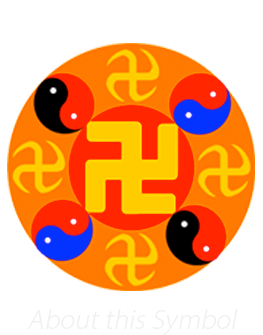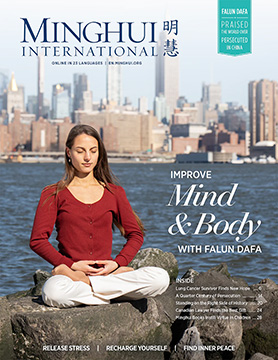(Minghui.org) Do divine beings really exist? Some say no because they only believe in what they can see with the naked eye. But this logic does not really stand. For example, we cannot see air, but we cannot live without it. We cannot see electromagnetic waves, but we know they must exist when we use cell phones.
In this article, we will explore this topic further, from ancient stories to scientific findings, and from Buddhism to many phenomena around us.
Forgiveness and Blessings
Han Shu (Book of Han), one of the classic history books of China, documents the story of Wang Wengru, a senior official in the Han Dynasty. To suppress rebellions, Wang and other officials were instructed by the emperor to execute anyone suspected of being rebellious. While other officials abused their power and killed many innocent people, Wang was different. He rarely killed those involved in the rebellions or punished local officials. Instead, he tried to persuade the mobsters to drop their weapons and become good citizens. Many mobsters were moved and followed his advice. Seldom was anyone executed at his directive and about 10,000 people were spared.
However, due to neglecting orders from the emperor, Wang was demoted and moved to Yuancheng (in today’s Hebei Province). “I heard a person who saves 1,000 people would be rewarded,” he commented, “I have saved 10,000 and hope my offspring will be blessed.”
Later on, Wang’s granddaughter Wang Zhengjun became queen and subsequently empress dowager with many of their relatives receiving titles. This made the Wang family one of the most prestigious ones in the Han Dynasty.
Divine Power
Wang’s story is in line with a belief in traditional Chinese culture, “Good is rewarded with good and evil meets evil.” Ancient Chinese had always believed that the divine watches mankind’s every move, rewarding or punishing people accordingly. Being a good person and helping others, one would be blessed by the divine. Conversely, doing bad deeds would result in misfortune.
In other words, while the divine is invisible, ancient people experienced its existence, seeing the consequences that followed their actions. In addition to Wang’s story, our connection with the divine was also seen in numerous other aspects. For instance, literary works and folklore depicted the existence of the divine, such as Journey to the West and the legend of Eight Immortals. During major events such as New Year and weddings, there was ritual to worship and thank the divine for protection. In Western society, holidays such as Christmas, Easter, and Passover as well as church visits on Sundays also highlight people’s belief in the existence of the divine.
Looking up in the sky, one may wonder how could the stars and planets move in such an orderly manner. Who governs the wondrous universe and keeps things under control? Many scientists have turned to the divine for an explanation.
Isaac Newton was one of the greatest mathematicians and physicists. He developed classical mechanics, advanced optics, and calculus. But in his most well-known book, Mathematical Principles of Natural Philosophy, he wrote, “This most beautiful system of the sun, planets and comets, could only proceed from the counsel and dominion of an intelligent and powerful Being...This Being governs all things, not as the soul of the world, but as Lord over all; and on account of his dominion he is wont, to be called Lord God.”
Albert Einstein, too, shared his religious viewpoints many times. “Science without religion is lame,” he said, “I want to know how God created this world. I am not interested in this or that phenomenon, in the spectrum of this or that element. I want to know his thoughts. The rest are details.”
Modern Day Miracles
Built 1,200 years ago in the Tang Dynasty, the 71-meter Leshan Giant Buddha in Sichuan Province is the largest and tallest stone Buddha statue in the world. Witnesses said the Buddha statue has closed her eyes with tears streaming down four times in recent history.
The first time happened during the Great Chinese Famine in 1962. Many people were starved to death with corpses floating in the river. A picture of the Buddha closing her eyes is still kept at the Leshan Museum.
The second incident was before the Cultural Revolution in 1963. To discourage people’s faith in the divine, the Chinese Communist Party (CCP) officials spent 40 million yuan cleaning the Buddha statue but were unable to erase tears in the corners of the eyes. Not long after that, about 100 million people were targeted in the Cultural Revolution havoc with about 20 million losing their lives.
The third time occurred in 1976. Because of the CCP’s man-made disaster, numerous people lost their lives in Tangshan Earthquake that year. Although the CCP claimed the death toll to be 240,000, inside information showed it was as high as 650,000.
The fourth time happened when Mr. Li Hongzhi, founder of Falun Dafa (a meditation system based on the principles of Truthfulness-Compassion-Forbearance), and some of his his disciples visited the Leshan Buddha statue on June 7, 1994. One disciple saw through his third eye that the Buddha statue was crying. When the disciple asked Master Li why, Master said the Buddha had been waiting for this moment in history for a long time. As they approached the Buddha, the same student saw the Buddha statue smiling again with happiness.
Another connection with the divine happened in South Korea in 1997 when the mystical flower of Udumbara appeared. Later on, the flowers also appeared in many other places around the world including Japan, Taiwan, Thailand, Hong Kong, Malaysia, Singapore, Australia, United States, Europe, and China.
According to Buddhist scripture Huilin Yinyi (a composite collection of all the glossaries of scriptural words and expressions compiled in and before the Tang Dynasty), “The Udumbara flower is an auspicious flower from heaven and does not exist in the mundane world. If a Tathagata or King of the Golden Wheel comes to the human world, with his great merits and virtue, the flower will manifest.”
A similar description also appeared in the Buddhist scripture Fahua Wenju (also known as the Lotus Sūtra), stating that “the mystical Udumbara flower blooms once every three thousand years, and its blossom heralds the advent of King of the Golden Wheel.”
Similarity, Buddha Sakyamuni once told his disciples that, when the Udumbara appeared, it was an indication that the Holy King of Falun would come to this world saving people.
The biggest challenge to the world today is the totalitarian CCP regime. Due to its cover-up and misinformation of the pandemic, over half a billion people around the world were infected and more than 6 million lost their lives.
But the harm wrought by the CCP extends far beyond this. By launching one political campaign after another, it has killed around 80 million innocent Chinese people since it took power in 1949. After systematically wiping out traditional Chinese culture, it launched a nationwide campaign against Falun Dafa and its principles of Truthfulness-Compassion-Forbearance in July 1999.
Living in a society with uncertainties, we know keeping traditional values in our mind will reconnect us with the divine. By rejecting the CCP and supporting the innocent, we will be blessed with health and prosperity.
Related article in Chinese:
All content published on this website is copyrighted by Minghui.org. Minghui will produce compilations of its online content regularly and on special occasions.
Category: News Commentary








